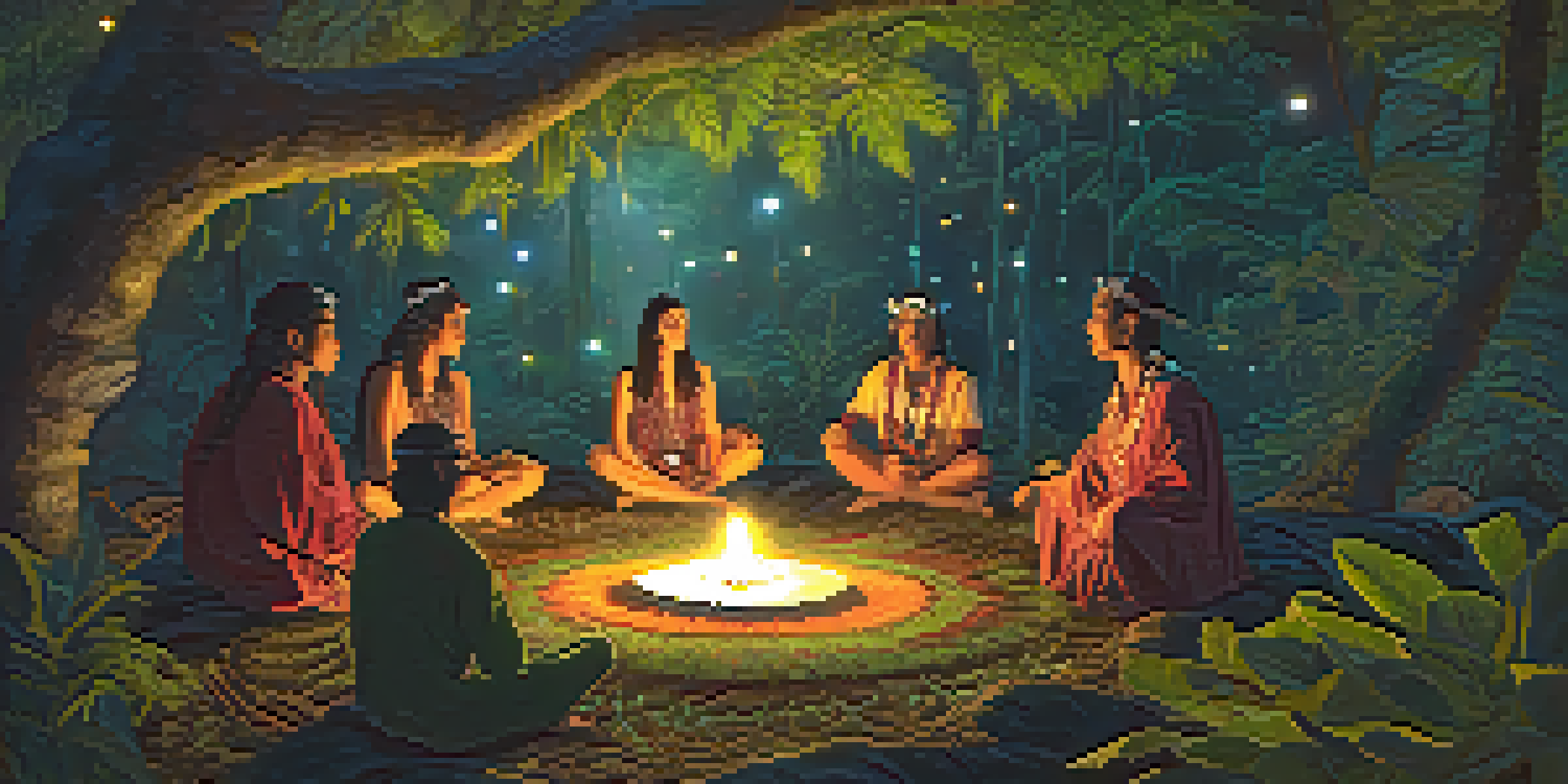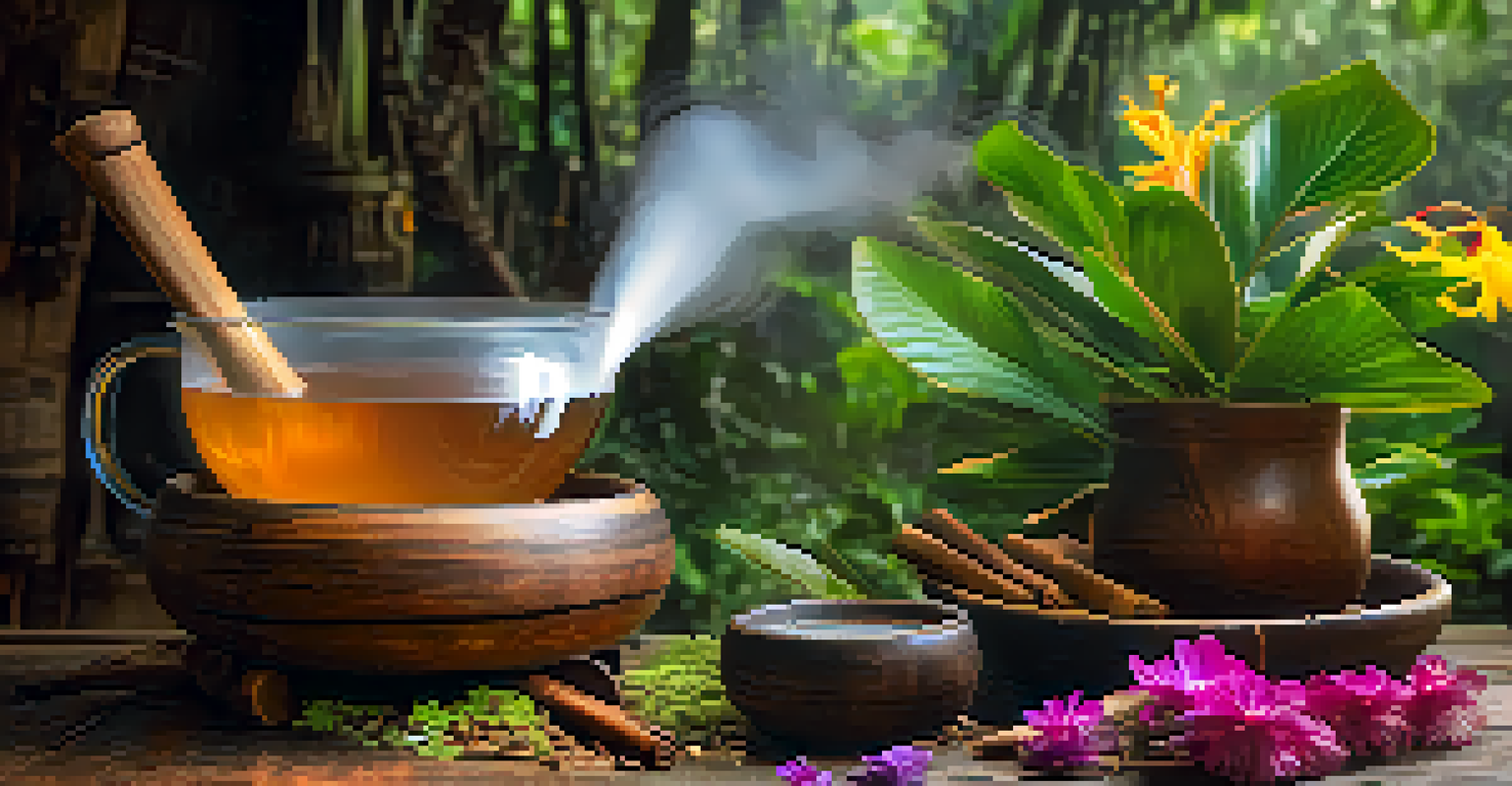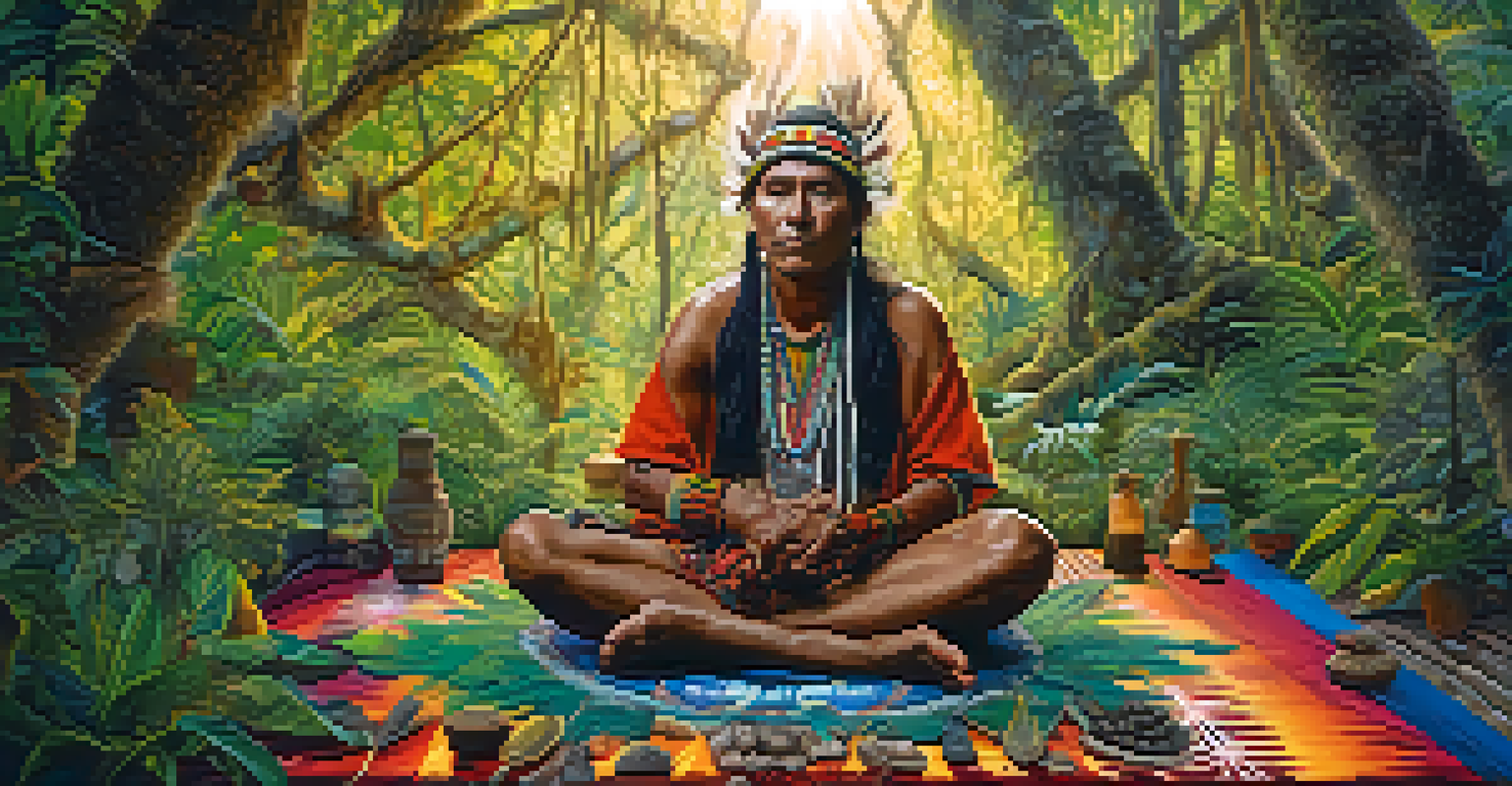Exploring Ayahuasca Ceremonies and Cultural Heritage

What is Ayahuasca and its Origins?
Ayahuasca is a powerful plant-based brew traditionally used by indigenous tribes in the Amazon rainforest. The term 'Ayahuasca' translates to 'vine of the souls' in Quechua, highlighting its spiritual significance. This brew typically combines the Banisteriopsis caapi vine with other plants containing DMT, a potent psychedelic compound.
Ayahuasca is a teacher, a healer, and a guide that shows us our deepest selves.
Historically, Ayahuasca has been used for centuries as a means of spiritual healing and connecting with the divine. Shamans, or spiritual healers, guide ceremonies, utilizing their deep knowledge of the plant's properties and cultural significance. The ritualistic aspect of Ayahuasca ceremonies emphasizes community, respect, and a connection to nature.
Today, Ayahuasca has gained popularity beyond the Amazon, attracting individuals seeking personal growth, healing, and deeper understanding of themselves. However, this surge in interest raises questions about cultural appropriation and the preservation of indigenous practices.
Understanding the Ceremony Structure
Ayahuasca ceremonies are often held in a sacred space, designed to facilitate introspection and spiritual connection. Participants typically gather in a circle, creating a sense of community and shared experience. The shaman opens the ceremony with prayers and intentions, setting a respectful tone for the journey ahead.

Once the brew is consumed, participants may experience a range of sensations, from visual hallucinations to deep emotional releases. The effects can vary widely, and the journey is often described as deeply personal and transformative. Throughout the night, the shaman sings icaros, traditional songs that guide participants and help navigate their experiences.
Ayahuasca's Cultural Roots
Ayahuasca is a sacred brew with deep spiritual significance for Amazonian tribes, serving as a vital link to their cultural heritage and collective healing.
After the ceremony, there's often a period of sharing and reflection, where participants can discuss their experiences and insights. This debriefing is an essential part of the process, reinforcing the communal aspect of the journey and allowing for deeper understanding and integration of the experience.
Cultural Significance of Ayahuasca
Ayahuasca is deeply intertwined with the cultural heritage of the Amazonian tribes, serving as a bridge to their ancestors and spiritual beliefs. It plays a crucial role in rituals, healing practices, and even in the governance of community life. The wisdom gained from these ceremonies is often passed down through generations, preserving the rich history of indigenous knowledge.
The spirit of Ayahuasca seeks to heal the soul and guide the seeker towards their true path.
For many tribes, the use of Ayahuasca is not just a personal journey but a communal one, reinforcing social bonds and cultural identity. The shared experience fosters a sense of belonging and unity among participants, highlighting the importance of collective healing in their traditions. It’s a reminder that spirituality often thrives in community.
As awareness of Ayahuasca spreads globally, there's a growing movement to ensure that the rights of indigenous peoples are respected. Advocates emphasize the need for ethical practices in how Ayahuasca is shared and consumed, ensuring that the cultural heritage is honored and protected.
Health Benefits and Risks of Ayahuasca
Many participants report profound psychological and emotional healing after participating in Ayahuasca ceremonies. Anecdotal evidence suggests it can help with issues like depression, PTSD, and addiction by providing insights and facilitating emotional release. The experience often leads to a sense of clarity and connection to one’s purpose.
However, it's crucial to approach Ayahuasca with caution, as it is not without risks. The brew can provoke intense emotional and physical reactions, which may not be suitable for everyone. Individuals with certain medical conditions or those taking specific medications should avoid Ayahuasca, making a pre-ceremony consultation essential.
Ceremonial Structure and Support
Ayahuasca ceremonies involve guided experiences led by shamans, fostering a sense of community while providing emotional and psychological support.
The importance of a safe, guided environment cannot be overstated. Experienced shamans can help manage the challenges that arise during the journey, ensuring participants are supported throughout their experience. This highlights the importance of choosing reputable retreat centers that prioritize safety and ethical practices.
The Role of Shamans in Ayahuasca Ceremonies
Shamans hold a vital role in Ayahuasca ceremonies, acting as spiritual guides and healers. Their extensive knowledge of plants, medicinal properties, and spiritual traditions enables them to facilitate transformative experiences for participants. The shaman’s role is not just to administer the brew but to create a safe and sacred space for healing.
During the ceremony, shamans use traditional songs known as icaros to guide participants through their journeys. These songs are believed to carry healing energy and help navigate the often tumultuous emotional landscapes that arise. The presence of a shaman can provide comfort and reassurance, making the experience feel more grounded.
Furthermore, shamans often conduct extensive preparation and integration sessions, helping participants process their experiences afterward. This ongoing support is crucial for helping individuals make sense of their insights and apply them to their daily lives, ensuring that the journey transcends the ceremony itself.
Ethical Considerations and Cultural Sensitivity
As the popularity of Ayahuasca grows outside of indigenous cultures, ethical considerations about cultural appropriation have come to the forefront. It’s essential for outsiders to approach Ayahuasca with respect and a genuine desire to understand its cultural roots. Engaging with indigenous communities and honoring their practices is crucial in maintaining the integrity of these traditions.
Many advocates stress that the commercialization of Ayahuasca can dilute its spiritual significance and exploit vulnerable communities. Ethical consumption involves supporting indigenous-led initiatives and participating in ceremonies that are rooted in genuine cultural practices. This ensures that the benefits of Ayahuasca are shared fairly with the communities that have preserved these traditions.
Ethical Use and Cultural Sensitivity
As Ayahuasca gains global popularity, it's essential to approach its use with respect for indigenous practices and a commitment to ethical consumption.
Cultural sensitivity also extends to understanding the historical context of colonization and its impact on indigenous peoples. Acknowledging this history fosters a deeper appreciation for the significance of Ayahuasca and promotes respectful engagement with its rich cultural heritage.
Future of Ayahuasca and Cultural Exchange
The future of Ayahuasca lies in the delicate balance of sharing its benefits with a global audience while respecting its cultural heritage. As more people seek out these transformative experiences, there is an opportunity for meaningful cultural exchange. This exchange can lead to greater understanding and respect for indigenous practices, provided it is approached thoughtfully.
With a growing body of research exploring the therapeutic potential of Ayahuasca, there’s hope for broader acceptance in mental health communities. This could lead to increased collaboration between indigenous practitioners and Western health professionals, fostering a holistic approach to well-being that honors both traditional and modern healing methods.

Ultimately, the journey with Ayahuasca is about connection—connecting with oneself, with others, and with the rich tapestry of human experience. By fostering respectful dialogue and collaboration, we can ensure that Ayahuasca continues to be a source of healing and insight for generations to come.